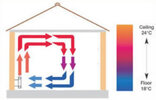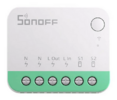@ericmark
Surely the TRV next to a radiator should be reading a higher temp not lower.
No although I note the energenie one claims to have a water sensor to compensate for the heat from the radiator direct, but once the thermals are started the hot air rising draws in cold are to bottom of radiator.
The receiver will only send the signal to the pilot wire when the room thermostat tells it to
Not really, making the pilot line reduced the temperature setting at the heater, one could fit a thermostat to the supply, but it would need to be double pole as the heater is class II so since very few if any thermostats are double pole it would need a relay, and can't see it is worth all the messing around.
Putting it simple I would not want to heat the home with electric to start with, so maybe I am not the right person to ask, the reason why I have worked out how the home is heated, is my own heating is not working as it should. So I have gone around with thermometers to see what is going on. My first house was hot air, worked great but expensive to run, but since it worked never really played with it, second house upstairs got too hot, fitted TRV's upstairs, then all worked A1 so again forgot about it, it worked so why worry.
So not until I went to look after mother with a house with internal doors down stairs, did I come across a heating which did not heat the house as wanted, some rooms hot and some rooms cool. And I started to look at how a home should be heated. Pictures like this

are not really helpful as today most windows are double glazed, however it does show how the heat should be on the internal wall, not next to window, and for some reason we have traditionally fitted heaters under the window, maybe because can't put furniture there? This one

tries to show how it circulates and how under the heater is a good place to monitor air temperature, however the building regulations stipulate the height of the thermostat on the wall at a position where we can both see it and access it, and say it should be on opposite wall to heater, mainly one assumes as placed so high, but today the wall thermostat is more like a hub, taking demands for heat from the electronic TRV heads, but this is because we have a central heating boiler which has a minimum and maximum output, with electric panel heaters it should be simple, the thermostat is built into the heater, no need to mess around, I had something similar with my Myson fan assisted heater on my old central heating.
The main problem today is to stop all the thermostats fighting each other, set at different heights in the room, they will not show same temperature, and the difference changes with the temperature outside, summer no heating on all mine show same temperature, but winter there can be a wide variation.
With central heating the answer is analogue control, this is far better than digital (on/off) there has been attempts with digital to use a mark/space ratio to start switching the heater on/off/on/off and as the temperature gets closer to the target to increase the off and decrease on time, to try to emulate analogue control and reduce the hysteresis, but this means the contacts wear out quicker, using semi-conductors one can change how much heat is released, but in real terms easier to fit the heater with oil to damp down the difference between on and off.
There is a balance the storage heater takes too long to re-heat a room, the delay between turning on power and getting heat is too long, the inferred heater is the opposite heat felt immediately, but also cold felt intermediately when switched off, it will vary room to room and home to home which is the best, but in general the oil filled radiator is about the best compromise with resistive heating, but clearly running costs drop using a heat pump.






